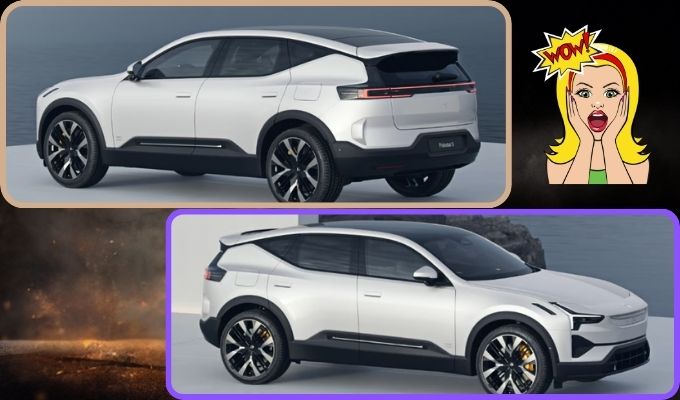2024 Polestar 3 Review
It’s hard to believe that sleek, slight-looking machine is a full-sized SUV, designed to take on the might of such behemoths as the Porsche Cayenne, the Audi Q8 e-tron, and the BMW iX.
But that’s what it is, This is the first SUV from the Chinese-Swedish brand Polestar. It’s called the Polestar 3, and it’s a hell of a looker.
Polestar Spends an insane amount of time here developing their cars. Their theory is that if a vehicle can work in Freezing conditions Then it can work anywhere.
Sleek Design
The Polestar 3 is quite wide and low with this sloping roof line, which is absolutely beautiful.

It also has the batteries under the floor, like all EVs, which creates a very low center of gravity, which is very helpful for what you see going on in the background.
It’s also got a perfect 50/50 weight balance, which means the car pivots around the middle, which is perfect for drifting. Who buys SUVs for anything else but drifting?
Size and Spaciousness
While the Polestar 3 looks diminutive, it’s really not because it’s almost 5 meters long, 1.6 meters high, and close to 2 meters wide.
That means it’s plenty spacious inside with one of those huge glass roofs that all EVs seem to have fitted as a matter of course these days, which vastly improves the sense of light and airiness for rear passengers who also get plenty of leg and knee room.
The boot space for the Polestar 3 is reasonable at 484 liters, but it’s well short of something like a Porsche Cayenne, which Polestar considers the competitor, a car that has at least 620 liters of boot space.
Polestar also points to its innovative labeling of seat materials, which outlined the materials used in those seats and their carbon impact.
Pricing and Innovative Features
Polestar is stepping up and away from its previous vehicles with the three, and into a new, more premium European price range.
The long-range dual motor Polestar 3 starts at $132,900, and the addition of the performance pack takes that price to $141,900.
Either version comes with an excellent 25-speaker Bower and Wilkins audio system with 1610 watts of Womping power as standard.
Dual-Motor Powertrain and Performance
The new Polestar 3 is offered as standard with two motors, one on the front axial and one on the rear for ICE-friendly all-wheel drive.
Power distribution is constantly controlled by computers and software for optimal delivery of its 360 kilowatts and 840 Newton meters of torque, and those figures rise to 380 kilowatts and 910 Newton meters with a performance pack.
The acceleration times for the two variants are 0 to 100 kilometers now in 5 seconds flat for the standard car, or 4.7 seconds for the Polestar 3 with performance pack.
Polestar claims a range of 610 kilometers for the long Range dual motor model or 560 kilometers for the more zesty performance pack version.
Charging Capabilities
I can tell you, you won’t be getting anywhere near those figures if you’re abusing the batteries by running the car in sub-freezing conditions.
On a 250 kilowatt DC charger, the Polestar 3 can be charged from 10% to 80% in just 30 minutes.
with an 11 kilowatt AC charger, it would take up to 10 hours to fully charge its 111 kilowatt hour lithium ion 400 V battery.
EV Advantages
One of the bonuses of the EV design, of course, is being able to put all the weight under the floor. That’s where the batteries live.
And impressively in this car, they’ve managed to get the center of gravity to the same level as a Polestar 1, which was a car, not an SUV.
It also means that they managed to get a perfect 50/50 weight balance front to rear, which when you’re doing this thing, is very handy because it means the pivot point of the car is at the very center, and that makes it feel more balanced and easier to drive.
Interior Excellence
A 50/50 weight balance is much easier to do when you don’t have a big lump of metal over the nose.

So again, electric cars have certain advantages. The steering is excellent. The car feels perfectly balanced.
You can really feel that 50,50 weight balance, and it just pivots so perfectly like a mid-engine car.
I did think that the torque delivery would be a problem in an EV because on slippery roads, you’re going to put so much power down so quickly.
Performance Version
You think you’re just going to spin and stay where you are. Again, the cleverness of the torque vectoring is that if It puts the power where it’s needed.
It can go from rear to front. If you’re just cruising on a highway, it completely disconnects the rear axel, and you become a front-wheel drive car and save on power and increase your range.
Now, this car is designed to compete with the likes of the Porsche’s KN, BMW’s very futuristic-looking iX.
This thing doesn’t look as disturbing. The Polestar 3 looks sleek and looks smaller than those cars, but it is spacious inside.
It’s very pleasant, It’s got that Scandinavian minimalism, interior is very nice.
All kinds of recycled materials as usual, but plenty of room for a family of five.
The theory at Polestar is that if you can get a car to work here in these extreme conditions, and they are extreme, then it will work anywhere.
For batteries, really cold weather is the hardest work they can do.
